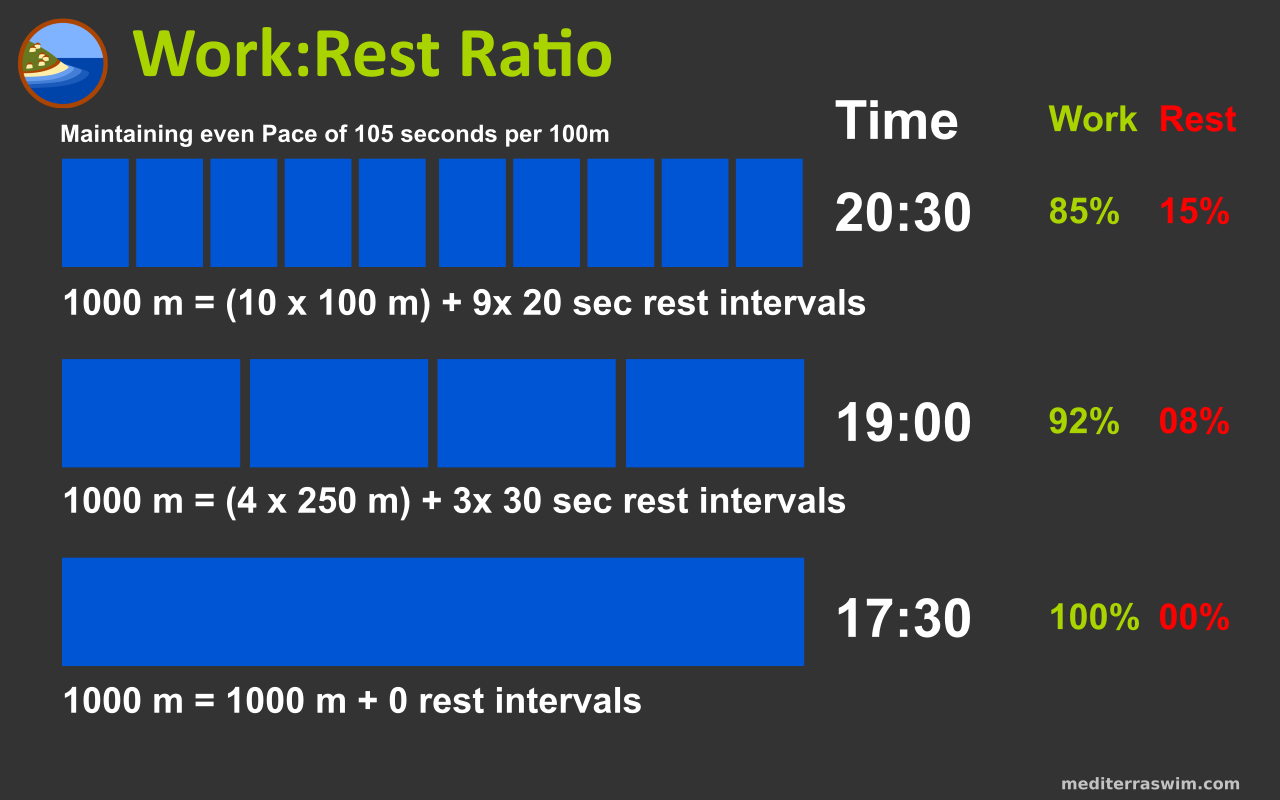Forums › Library › Knowledge Base › Work:Rest Ratio
Please type your comments directly in the reply box - DO NOT copy/paste text from somewhere else into the reply boxes - this will also copy the code behind your copied text and publish that with your reply, making it impossible to read. Our apology for the inconvenience, but we don't see a convenient way of fixing this yet.
Tagged: intervals, knowledge base, rest intervals, work rest ratio
-
AuthorPosts
-
August 20, 2014 at 18:00 #3276
Admin Mediterra
KeymasterThe Work:Rest Ratio refers to the % or ratio of swimming time to resting time. When you are swimming (and counting that distance) you are ‘working’. And when you are not swimming – i.e. sitting at the wall – you are ‘resting’ in the form of Passive Rest. When you use a length or two of drill or slow-swimming between your work intervals to recover heart rate and attention, this is called Active Rest.
If a swimmer is in a 100m race and took 60 seconds to finish, and never stops or never rests in any form he has is at 0% Rest. If he stop at the wall once for 3 seconds and then continues and finishes in 60 seconds then he has 95% Work and 5% Rest or 55:3 Ratio.
In Work:Rest there are four variables to examine:
- the total distance of the set/swim,
- the total time it takes to complete the set/swim,
- the amount of time spent swimming, and
- the amount of time spent resting.
In the early stages of Interval Training a swimmer might have a high amount of rest compared to the amount of work. For some swimmers, it could be like 50% rest – 30 seconds (25m) swimming and 30 seconds rest at the wall. This is a lot of rest, and may seem like it is not very good – but we also need to look at what kind of Pace he is holding on those short repeats compared to what this swimmer could do if he was allowed no rest – if he can complete total distance faster including rest time than he could do it with no rest then this could actually be a very good sign
Note: this is actually a technique some successful marathon runners use to produce a faster overall time! They might run 8 minutes faster than marathon pace, then walk for 20 seconds and end up finishing the marathon faster than if they just tried to run continuously at their best pace.
The end objective for interval training is to remove all the ‘rest’ (considering that subtle forms of Active Rest can be built into even an elite level race) while swimming as fast as one could possibly swim for the amount of energy he/she wants to spend (and Olympic swimmer may intend to completely exhaust his energy supply by the end of the swim, while an Olympic triathlete will definitely not want to exhaust herself!).

Let’s compare two ways a swimmer could approach a 800 meter set:
A – Continuous Swimming
At a strong effort level Fredrick can swim 800 meters continuous at a Pace of 2:15 minutes per 100m for a total time of 18 minutes. So, he is swimming 800m at 2:15 Pace with 0% Rest.
B – Interval Training
Fredrick breaks up that 800 meters into 8x 100 meter pieces and will use 20 seconds Passive Rest at the wall. He is able to hold 1 minute 50 seconds per 100m – so when he adds up his rest time (7x 20 seconds = 1:20 minutes) and his work time (8x 1:50 minutes = 14:40 minutes) he finds that he can actually complete 800m in 16 minutes total. So, Fredrick was swimming 800m at 1:50 Pace with 8% Rest.
Fredrick could swim 2 minutes faster at 1:50 Pace with Rest Intervals than he could do it if he took no rest.
The next step for Fredrick would be one of two options:
1) Keep the same Passive Rest interval (20 seconds) and make fewer rest stops – which means he need to lengthen his distance intervals, from 100m to maybe 150m. Instead of 7 rest times he would only have 5 of them.(5x 150) + 50m with 20 seconds Passive Rest (5 rest intervals = 100 seconds of rest).
2) Or he can keep the same distance intervals, and shorten the rest interval slightly –
8x 100m with 15 seconds Passive Rest (7 rest intervals = 105 seconds of rest).
Both of these will challenge his fitness (ability to work at intensity then recover quickly) from a different angle.
-
AuthorPosts
- The topic ‘Work:Rest Ratio’ is closed to new replies.
